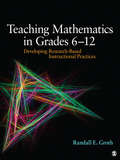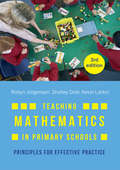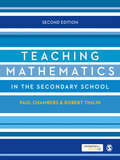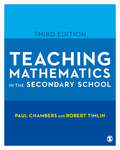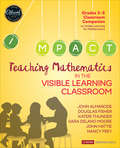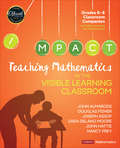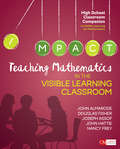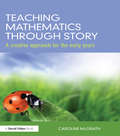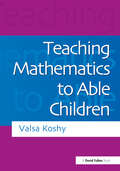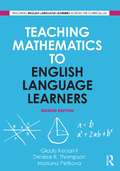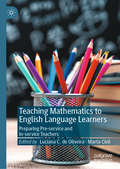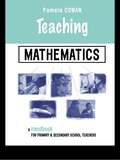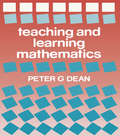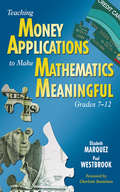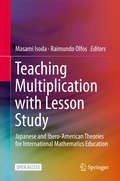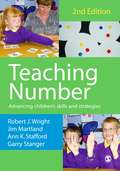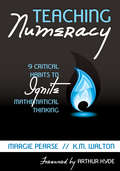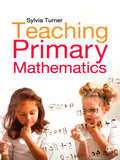- Table View
- List View
Teaching Mathematics in Grades 6 - 12: Developing Research-Based Instructional Practices
by Randall E. GrothA journey into the vibrant and intriguing world of mathematics educationTeaching Mathematics in Grades 6 - 12 explores how research in mathematics education can inform teaching practice in grades 6-12. The author shows secondary mathematics teachers the value of being a researcher in the classroom by constantly experimenting with methods for developing students′ mathematical thinking and then connecting this research to practices that enhance students′ understanding of the material.The chapters in Part I introduce secondary teachers to the field of mathematics education with cross-cutting issues that apply to teaching and learning in all mathematics content areas. The chapters in Part II are devoted to specific mathematics content strands and describe how students think about mathematical concepts. The goal of the text is to have secondary math teachers gain a deeper understanding of the types of mathematical knowledge their students bring to grade 6 – 12 classrooms, and how students′ thinking may develop in response to different teaching strategies.
Teaching Mathematics in Primary Schools: Principles for effective practice
by Shelley Dole Robyn Jorgensen Kevin Larkin'This is an outstanding book: it should be high on the list of any primary school teacher's set of references and a required text for pre-service teachers.'Australian Primary Mathematics ClassroomIn our technology-rich world, numeracy is just as important as the smartphone in your pocket. Students need to develop mathematical ways of seeing the world and strong problem-solving skills, and those foundations are taught in the primary school classroom.Teaching Mathematics in Primary Schools covers the mathematical content taught in primary and middle years, always emphasising how students can connect what they learn in mathematics with other curriculum areas and with the world beyond the classroom. The authors draw on the latest international research to show how teachers can develop a rich repertoire of classroom teaching techniques, and effective planning, assessment and reporting methods. They outline approaches to creating supportive learning environments for all students, and to building their knowledge and confidence in using mathematics. This third edition has been updated throughout and includes a new chapter on numeracy. Evidence-based uses of digital technologies to support learning and teaching are included in every chapter. With practical strategies that can be implemented in the classroom, this book is an invaluable resource for pre-service and early career primary and middle years mathematics teachers.
Teaching Mathematics in the Secondary School (Developing as a Reflective Secondary Teacher)
by Mr Paul Chambers Robert Timlin'Chambers and Timlin write with clarity and purpose. The authors link the theory of teaching mathematics with simple reflective questions and interesting maths tasks. There is practical advice on planning, assessment and differentiations, amongst other pertinent themes' -Jacqueline Oldham, PGCE Secondary Mathematics Course Tutor, St Mary's University College 'This is a very practical guide for learning to teach mathematics for student teachers on all training routes. Chapters are focused and readable but succeed in tackling issues in depth giving the reader strong academic support' -Anne Haworth, PGCE Secondary Mathematics Course Tutor, University of Manchester This book is an essential companion for anyone training to teach mathematics in secondary education. It offers clear and engaging coverage of all major aspects of mathematics teaching that you will need to engage with in order to successfully train for the classroom. This Second Edition includes: a new chapter exploring different teaching approaches including active learning, effective group work and creative mathematics teaching expanded coverage of assessment, using resources in the classroom and metacognition and learning updated coverage of recent developments in education policy and the 2012 Teachers' Standards This is essential reading for anyone training to teach secondary mathematics including postgraduate (PGCE, SCITT) and school-based routes into teaching. Free digital resources for extra support is available in the book's companion website. It includes: Web links and further reading for each chapter A video series of a sample classroom lesson filmed in a real-life setting Visit www.sagepub.co.uk/chamberstimlin
Teaching Mathematics in the Secondary School (Developing as a Reflective Secondary Teacher)
by Mr Paul Chambers Robert TimlinThis fully updated third edition looks at the fundamentals of mathematics teaching, how to plan lessons and assess learning, and how to promote an inclusive approach in the classroom. Key new features include: Updated content reflecting: the 2014 National Curriculum in England, the Teachers' Standards and revised requirements for GCSE and A level mathematics Updated 'Evidence from research' features, highlighting developments in the field An expanded section on mathematical misconceptions New coverage on teaching for mastery.
Teaching Mathematics in the Secondary School (Developing as a Reflective Secondary Teacher)
by Mr Paul Chambers Robert TimlinThis fully updated third edition looks at the fundamentals of mathematics teaching, how to plan lessons and assess learning, and how to promote an inclusive approach in the classroom. Key new features include: Updated content reflecting: the 2014 National Curriculum in England, the Teachers' Standards and revised requirements for GCSE and A level mathematics Updated 'Evidence from research' features, highlighting developments in the field An expanded section on mathematical misconceptions New coverage on teaching for mastery.
Teaching Mathematics in the Visible Learning Classroom, Grades 3-5 (Corwin Mathematics Series)
by Douglas Fisher Nancy Frey John Hattie John T. Almarode Sara Delano Moore Kateri ThunderIt could happen in the morning during homework review. Or perhaps it happens when listening to students as they struggle through a challenging problem. Or maybe even after class, when planning a lesson. At some point, the question arises: How do I influence students′ learning—what’s going to generate that light bulb "aha" moment of understanding? In this sequel to the megawatt best seller Visible Learning for Mathematics, John Almarode, Douglas Fisher, Nancy Frey, John Hattie, and Kateri Thunder help you answer that question by showing how Visible Learning strategies look in action in the mathematics classroom. Walk in the shoes of elementary school teachers as they engage in the 200 micro-decisions-per-minute needed to balance the strategies, tasks, and assessments seminal to high-impact mathematics instruction. Using grade-leveled examples and a decision-making matrix, you’ll learn to Articulate clear learning intentions and success criteria at surface, deep, and transfer levels Employ evidence to guide students along the path of becoming metacognitive and self-directed mathematics achievers Use formative assessments to track what students understand, what they don’t, and why Select the right task for the conceptual, procedural, or application emphasis you want, ensuring the task is for the right phase of learning Adjust the difficulty and complexity of any task to meet the needs of all learners It’s not only what works, but when. Exemplary lessons, video clips, and online resources help you leverage the most effective teaching practices at the most effective time to meet the surface, deep, and transfer learning needs of every student.
Teaching Mathematics in the Visible Learning Classroom, Grades 3-5 (Corwin Mathematics Series)
by Douglas Fisher Nancy Frey John Hattie John T. Almarode Sara Delano Moore Kateri ThunderIt could happen in the morning during homework review. Or perhaps it happens when listening to students as they struggle through a challenging problem. Or maybe even after class, when planning a lesson. At some point, the question arises: How do I influence students′ learning—what’s going to generate that light bulb "aha" moment of understanding? In this sequel to the megawatt best seller Visible Learning for Mathematics, John Almarode, Douglas Fisher, Nancy Frey, John Hattie, and Kateri Thunder help you answer that question by showing how Visible Learning strategies look in action in the mathematics classroom. Walk in the shoes of elementary school teachers as they engage in the 200 micro-decisions-per-minute needed to balance the strategies, tasks, and assessments seminal to high-impact mathematics instruction. Using grade-leveled examples and a decision-making matrix, you’ll learn to Articulate clear learning intentions and success criteria at surface, deep, and transfer levels Employ evidence to guide students along the path of becoming metacognitive and self-directed mathematics achievers Use formative assessments to track what students understand, what they don’t, and why Select the right task for the conceptual, procedural, or application emphasis you want, ensuring the task is for the right phase of learning Adjust the difficulty and complexity of any task to meet the needs of all learners It’s not only what works, but when. Exemplary lessons, video clips, and online resources help you leverage the most effective teaching practices at the most effective time to meet the surface, deep, and transfer learning needs of every student.
Teaching Mathematics in the Visible Learning Classroom, Grades 6-8 (Corwin Mathematics Series)
by Douglas Fisher Nancy Frey John Hattie John T. Almarode Sara Delano Moore Joseph AssofSelect the right task, at the right time, for the right phase of learning It could happen in the morning during homework review. Or perhaps it happens when listening to students as they struggle through a challenging problem. Or maybe even after class, when planning a lesson. At some point, the question arises: How do I influence students′ learning—what’s going to generate that light bulb "aha" moment of understanding? In this sequel to the megawatt best seller Visible Learning for Mathematics, John Almarode, Douglas Fisher, Nancy Frey, John Hattie, and Kateri Thunder help you answer that question by showing how Visible Learning strategies look in action in the mathematics classroom. Walk in the shoes of middle school teachers as they engage in the 200 micro-decisions-per-minute needed to balance the strategies, tasks, and assessments seminal to high-impact mathematics instruction. Using grade-leveled examples and a decision-making matrix, you’ll learn to Articulate clear learning intentions and success criteria at surface, deep, and transfer levels Employ evidence to guide students along the path of becoming metacognitive and self-directed mathematics achievers Use formative assessments to track what students understand, what they don’t, and why Select the right task for the conceptual, procedural, or application emphasis you want, ensuring the task is for the right phase of learning Adjust the difficulty and complexity of any task to meet the needs of all learners It’s not only what works, but when. Exemplary lessons, video clips, and online resources help you leverage the most effective teaching practices at the most effective time to meet the surface, deep, and transfer learning needs of every student.
Teaching Mathematics in the Visible Learning Classroom, Grades 6-8 (Corwin Mathematics Series)
by Douglas Fisher Nancy Frey John Hattie John T. Almarode Sara Delano Moore Joseph AssofSelect the right task, at the right time, for the right phase of learning It could happen in the morning during homework review. Or perhaps it happens when listening to students as they struggle through a challenging problem. Or maybe even after class, when planning a lesson. At some point, the question arises: How do I influence students′ learning—what’s going to generate that light bulb "aha" moment of understanding? In this sequel to the megawatt best seller Visible Learning for Mathematics, John Almarode, Douglas Fisher, Nancy Frey, John Hattie, and Kateri Thunder help you answer that question by showing how Visible Learning strategies look in action in the mathematics classroom. Walk in the shoes of middle school teachers as they engage in the 200 micro-decisions-per-minute needed to balance the strategies, tasks, and assessments seminal to high-impact mathematics instruction. Using grade-leveled examples and a decision-making matrix, you’ll learn to Articulate clear learning intentions and success criteria at surface, deep, and transfer levels Employ evidence to guide students along the path of becoming metacognitive and self-directed mathematics achievers Use formative assessments to track what students understand, what they don’t, and why Select the right task for the conceptual, procedural, or application emphasis you want, ensuring the task is for the right phase of learning Adjust the difficulty and complexity of any task to meet the needs of all learners It’s not only what works, but when. Exemplary lessons, video clips, and online resources help you leverage the most effective teaching practices at the most effective time to meet the surface, deep, and transfer learning needs of every student.
Teaching Mathematics in the Visible Learning Classroom, Grades K-2 (Corwin Mathematics Series)
by Douglas Fisher Nancy Frey John Hattie John T. Almarode Kateri ThunderSelect the right task, at the right time, for the right phase of learning Young students come to elementary classrooms with different background knowledge, levels of readiness, and learning needs. What works best to help K–2 students develop the tools to become visible learners in mathematics? What works best for K-=–2 mathematics learning at the surface, deep, and transfer levels? In this sequel to the megawatt bestseller Visible Learning for Mathematics, John Almarode, Douglas Fisher, Kateri Thunder, John Hattie, and Nancy Frey help you answer those questions by showing how Visible Learning strategies look in action in K–2 mathematics classrooms. Walk in the shoes of teachers as they mix and match the strategies, tasks, and assessments seminal to making conceptual understanding, procedural knowledge, and the application of mathematical concepts and thinking skills visible to young students as well as to you. Using grade-leveled examples and a decision-making matrix, you’ll learn to Articulate clear learning intentions and success criteria at surface, deep, and transfer levels Employ evidence to guide students along the path of becoming metacognitive and self-directed mathematics achievers Use formative assessments to track what students understand, what they don’t, and why Select the right task for the conceptual, procedural, or application emphasis you want, ensuring the task is for the right phase of learning Adjust the difficulty and complexity of any task to meet the needs of all learners It’s not only what works, but when. Exemplary lessons, video clips, and online resources help you leverage the most effective teaching practices at the most effective time to meet the surface, deep, and transfer learning needs of every K–2 student.
Teaching Mathematics in the Visible Learning Classroom, Grades K-2 (Corwin Mathematics Series)
by Douglas Fisher Nancy Frey John Hattie John T. Almarode Kateri ThunderSelect the right task, at the right time, for the right phase of learning Young students come to elementary classrooms with different background knowledge, levels of readiness, and learning needs. What works best to help K–2 students develop the tools to become visible learners in mathematics? What works best for K-=–2 mathematics learning at the surface, deep, and transfer levels? In this sequel to the megawatt bestseller Visible Learning for Mathematics, John Almarode, Douglas Fisher, Kateri Thunder, John Hattie, and Nancy Frey help you answer those questions by showing how Visible Learning strategies look in action in K–2 mathematics classrooms. Walk in the shoes of teachers as they mix and match the strategies, tasks, and assessments seminal to making conceptual understanding, procedural knowledge, and the application of mathematical concepts and thinking skills visible to young students as well as to you. Using grade-leveled examples and a decision-making matrix, you’ll learn to Articulate clear learning intentions and success criteria at surface, deep, and transfer levels Employ evidence to guide students along the path of becoming metacognitive and self-directed mathematics achievers Use formative assessments to track what students understand, what they don’t, and why Select the right task for the conceptual, procedural, or application emphasis you want, ensuring the task is for the right phase of learning Adjust the difficulty and complexity of any task to meet the needs of all learners It’s not only what works, but when. Exemplary lessons, video clips, and online resources help you leverage the most effective teaching practices at the most effective time to meet the surface, deep, and transfer learning needs of every K–2 student.
Teaching Mathematics in the Visible Learning Classroom, High School (Corwin Mathematics Series)
by Douglas Fisher John Hattie Dr Nancy Frey John T. Almarode Joseph AssofSelect the right task, at the right time, for the right phase of learning How do you generate that lightbulb “aha” moment of understanding for your students? This book helps to answer that question by showing Visible Learning strategies in action in high-impact mathematics classrooms. Walk in the shoes of teachers as they engage in the countless micro-decisions required to balance strategies, tasks, and assessments, demonstrating that it’s not only what works, but when. A decision-making matrix and grade-leveled examples help you leverage the most effective teaching practices at the most effective time to meet the surface, deep, and transfer learning needs of every student.
Teaching Mathematics in the Visible Learning Classroom, High School (Corwin Mathematics Series)
by Douglas Fisher John Hattie Dr Nancy Frey John T. Almarode Joseph AssofSelect the right task, at the right time, for the right phase of learning How do you generate that lightbulb “aha” moment of understanding for your students? This book helps to answer that question by showing Visible Learning strategies in action in high-impact mathematics classrooms. Walk in the shoes of teachers as they engage in the countless micro-decisions required to balance strategies, tasks, and assessments, demonstrating that it’s not only what works, but when. A decision-making matrix and grade-leveled examples help you leverage the most effective teaching practices at the most effective time to meet the surface, deep, and transfer learning needs of every student.
Teaching Mathematics through Story: A creative approach for the early years
by Caroline McGrathHow do you make mathematics relevant and exciting to young children? How can mathematics and literacy be combined in a meaningful way? How can stories inspire the teaching and learning of mathematics? This book explores the exciting ways in which story can be used as a flexible resource to facilitate children’s mathematical thinking. It looks at the potential relationship between story and mathematics and practically demonstrates how they can be combined to help children connect, understand and express mathematical ideas using story language. Written for all early years practitioners and students, the book offers a playful pedagogical approach to facilitating children’s mathematical thinking which brings a creative satisfaction and confidence to teaching mathematics. Encouraging a creative approach to teaching mathematics that draws on picture books and oral mathematical stories, the book shows you how to: Move from reading to telling stories with mathematical themes Encourage children to pose and solve problems by playing with the plot of stories Enable children to translate abstract mathematical ideas to concrete representations with supporting story props and puppets Create original oral mathematical stories alongside children Capture children’s mathematical thinking in an observational framework, supported with audio or video recordings which can be shared with parents and colleagues There are free audio recordings of children and adults telling oral mathematical stories, which feature in the book. These can be downloaded from: www.routledge.com/9780415688154 This book draws on practical work with children, educators, parents, professional storytellers, and trainee practitioners, who bring theoretical ideas to life and offer insight into their mathematical story experiences. It is a ‘must have’ for all those who want to make mathematics relevant, accessible and imaginative for young children.
Teaching Mathematics to Able Children
by Valsa KoshyThis book enables teachers to effectively meet the needs of their most able mathematicians. Using a tried and tested set of principles developed and used by The Able Children's Education Unit at Brunel University, the author demonstrates how to: identify high mathematical ability in a pupil, plan suitably challenging activities and teach them most effectively within the existing National Numeracy framework, make the most of the classroom resources available, including ICT and external agencies, implement strategies for differentiation, illustrated with real-life classroom examples. Accessible in style and featuring practical case studies throughout, this book will give teachers and student teachers the confidence and knowledge to effectively challenge and develop the skills of the most able mathematician.
Teaching Mathematics to English Language Learners
by Denisse R. Thompson Gladis Kersaint Mariana PetkovaToday's mathematics classrooms increasingly include students for whom English is a second language. Teaching Mathematics to English Language Learners provides readers a comprehensive understanding of both the challenges that face English language learners (ELLs) and ways in which educators might address them in the secondary mathematics classroom. Framed by a research perspective, Teaching Mathematics to English Language Learners presents practical instructional strategies for engaging learners that can be incorporated as a regular part of instruction. The authors offer context-specific strategies for everything from facilitating classroom discussions with all students, to reading and interpreting math textbooks, to tackling word problems. A fully annotated list of math web and print resources completes the volume, making this a valuable reference to help mathematics teachers meet the challenges of including all learners in effective instruction. Features and updates to this new edition include: An updated and streamlined Part 1 provides an essential overview of ELL theory in a mathematics specific context. Additional practical examples of mathematics problems and exercises make turning theory into practice easy when teaching ELLs New pedagogical elements in Part 3 include tips on harnessing new technologies, discussion questions and reflection points. New coverage of the Common Core State Standards, as well as updates to the web and print resources in Part 4.
Teaching Mathematics to English Language Learners: Preparing Pre-service and In-service Teachers (English Language Education Ser. #17)
by Luciana C. de Oliveira Marta CivilThis edited book is about preparing pre-service and in-service teachers to teach secondary-level mathematics to English Language Learners (ELLs) in twenty-first century classrooms. Chapter topics are grounded in both research and practice, addressing a range of timely topics including the current state of ELL education in the secondary mathematics classroom, approaches to leveraging the talents and strengths of bilingual students in heterogeneous classrooms, best practices in teaching mathematics to multilingual students, and ways to infuse the secondary mathematics teacher preparation curriculum with ELL pedagogy. This book will appeal to all teachers of ELLs, teacher educators and researchers of language acquisition more broadly. This volume is part of a set of four edited books focused on teaching the key content areas to English language learners. The other books in the set focus on teaching History and Social Studies, English Language Arts, and Science to ELLs.
Teaching Mathematics: A Handbook for Primary and Secondary School Teachers (Teaching Series)
by Pamela CowanA practical introduction to Maths teaching designed specifically for beginning teachers in primary and secondary schools. It brings together the latest DfES and TTA guidelines and requirements with authoritative guidance, ensuring that readers feel confident about how to approach their role as a teacher. This book explores key issues in maths teaching today, including: planning and classroom management assessment, recording and reporting information and communication technology investigative mathematics equal opportunities, special needs and differentiation key skills and alternative mathematics qualifications being an effective maths teacher personal and professional development in the early stages of a teaching career.
Teaching Maths
by D.M. NealSchool mathematics is a complex subject and an ever-changing topic, but this book will help teachers, parents and employers to understand it better.
Teaching Middle School Mathematics
by Douglas K. BrumbaughMiddle school teaching and learning has a distinct pedagogy and curriculum that is grounded in the concept of developmentally appropriate education. This text is designed to meet the very specific professional development needs of future teachers of mathematics in middle school environments.Closely aligned with the NCTM Principles and Standards for School Mathematics, the reader-friendly, interactive format encourages readers to begin developing their own teaching style and making informed decisions about how to approach their future teaching career. A variety of examples establish a broad base of ideas intended to stimulate the formative development of concepts and models that can be employed in the classroom. Readers are encouraged and motivated to become teaching professionals who are lifelong learners.The text offers a wealth of technology-related information and activities; reflective, thought-provoking questions; mathematical challenges; student life-based applications; TAG (tricks-activities-games) sections; and group discussion prompts to stimulate each future teacher's thinking. "Your Turn" sections ask readers to work with middle school students directly in field experience settings. This core text for middle school mathematics methods courses is also appropriate for elementary and secondary mathematics methods courses that address teaching in the middle school grades and as an excellent in-service resource for aspiring or practicing teachers of middle school mathematics as they update their knowledge base.Topics covered in Teaching Middle School Mathematics:*NCTM Principles for School Mathematics;*Representation;*Connections;*Communication;*Reasoning and Proof;*Problem Solving;*Number and Operations;*Measurement;*Data Analysis and Probability;*Algebra in the Middle School Classroom; and*Geometry in the Middle School Classroom.
Teaching Money Applications to Make Mathematics Meaningful, Grades 7-12
by Paul Westbrook Elizabeth MarquezOffers teachers engaging ways to weave real-life financial issues and personal money management into NCTM standards–based secondary mathematics lessons while meeting equity and accountability requirements.
Teaching Multiplication with Lesson Study: Japanese and Ibero-American Theories for International Mathematics Education
by Masami Isoda Raimundo OlfosThis open access book is intended to assist teachers, teacher trainers, curriculum designers, editors and authors of textbooks in developing strategies to teach the multiplication of natural numbers based on the experience of the Lesson Study in Japan. This approach to mathematics education dates back to the 1870s and reconciles the emphasis on problem solving with the treatment of the curricular contents. It has gained international recognition since the 1990s and thanks to it mathematics education in Japan has been recognized as one of the most efficient and innovative in the world.This growing international awareness has led to an effort to apply the principles of Lesson Study to other parts of the world and this book shows how experienced authors from Brazil, Chile, Mexico, Spain and Portugal have worked to adapt some of these methods and techniques to the Portuguese and Spanish speaking countries of Ibero-America. Drawing on the impact of Lesson Study on government curriculum decisions and teacher behavior in Japanese classrooms; offering examples of lessons, lesson plans and suggestions for teaching; and presenting examples of the good reception of the principles of Lesson Study in Ibero-America, Teaching Multiplication with Lesson Study – Japanese and Ibero-American Theories for Mathematics Education shows how an efficient and cutting-edge experience in mathematics education can travel the world and help teachers in many different countries.
Teaching Number: Advancing Children′s Skills and Strategies (Math Recovery)
by Garry Stanger Ann K Stafford Robert J Wright James MartlandThe book lets teachers identify where their students are in terms of number skills, and sets out a strategy for developing their knowledge. The authors show how to advance children′s learning across five stages of early arithmetical learning - emergent, perceptual, figurative, initial number, and facile number. This provides for increasingly sophisticated number strategies across addition, subtraction, multiplication and division, as well as developing children′s number word and numeral knowledge, and their ability to structure number and have grouping strategies. The approach used nine guiding principles for teaching. Each chapter has clearly defined teaching procedures which show how to take the children onto the next more sophisticated stage. The teaching procedures are organized into key teaching topics, and each includes: a clearly defined purpose detailed instructions, activities, learning tasks and reinforcing games lists of responses which children may make application in whole class, small group and individualised settings a link to the Learning Framework in Number (see Early Numeracy- second edition, 2005) how the guiding principles for teaching can be used to allow teachers to evaluate and reflect upon their practice Primary practitioners in Australia, the United States, the United Kingdom and Canada have tested the teaching procedures which can be used in conjunction with each country′s numeracy strategy. Primary teachers, especially of the early years, mathematics co-ordinators, heads of school, mathematics advisers, special educationalists, learning support personnel, teacher assistants, lecturers in initial teacher training and educational psychologists will all find this book invaluable.
Teaching Numeracy: 9 Critical Habits to Ignite Mathematical Thinking
by Margaret M. Pearse Kathleen M. WaltonTransform mathematics learning from “doing” to “thinking” American students are losing ground in the global mathematical environment. What many of them lack is numeracy—the ability to think through the math and apply it outside of the classroom. Referencing the new common core and NCTM standards, the authors outline nine critical thinking habits that foster numeracy and show you how to: Monitor and repair students’ understanding Guide students to recognize patterns Encourage questioning for understanding Develop students’ mathematics vocabulary Included are several numeracy-rich lesson plans, complete with clear directions and student handouts.
Teaching Primary Mathematics
by Ms Sylvia TurnerTeaching Primary Mathematics covers what student teachers really need to know and why, including approaches to teaching and learning, planning and assessment, and using resources in maths teaching. It also provides a brief historical overview of the teaching of mathematics and examines strategies to enhance learning and development as a confident mathematician in the primary classroom. Informed by seminal and current research, and recent developments in education policy, the book also explores: - the role of mathematics within the primary curriculum - the development of mathematics as a subject of study - the knowledge that can be gained from considering international approaches to mathematics. This is essential reading for all students on primary initial teacher education courses including undergraduate (BEd, BA with QTS), postgraduate (PGCE, SCITT), and School Direct, and employment-based routes into teaching. Sylvia Turner is Senior Lecturer in the Faculty of Education at the University of Winchester.
